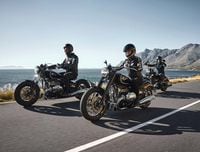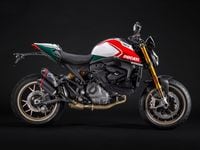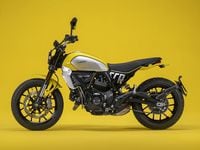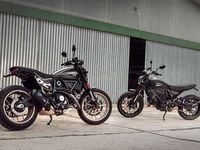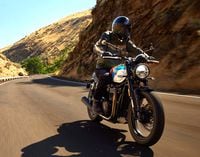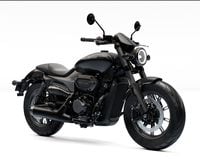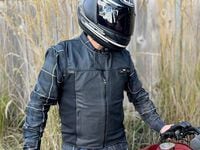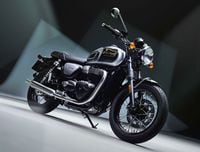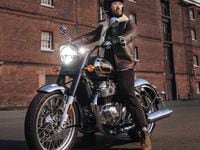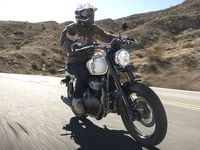Flamboyant. Fast. Fun.
The requirements were simple.As we set off down Sunset Boulevard toward the sea and a day of adventurous riding, we couldn't help but notice the attention. Passing motorists swiveled their heads like Linda Blair at the height of her tenure with the devil when they caught sight of the V-Rod, Rune, Vulcan 2000, Rocket III and V-Max. These are all distinctive motorcycles-all lookers in their own right-but put them in one place and their flamboyance is suddenly amplified a hundredfold. Like a troupe of Vegas showgirls taking a shortcut through Sunday mass, the super cruisers cannot be overlooked.
It's an unlikely grouping, of course. Our premise for contrasting these bikes is both logical and emotive: All are long on horsepower and short on conventionality. These are the heavyweight cruisers that run 12 seconds or better at the dragstrip. All are striking, conversation-stirring and undeniably interesting. And oh yes, fun.
As different as they are-especially when parked nose-to-tail with price tags fluttering-these bikes are also born for the same basic intention. It's not simply a contest of horsepower or style; each of these super cruisers is an exercise in individuality.
And Then There Was Horsepower
In 1985 Michael Jackson and Madonna had number-one songs. Ronald Reagan was president, the 49ers won the Super Bowl and a cold snap killed 90 percent of the oranges in Florida. It wasn't a very remarkable year, well, unless you count the Yamaha V-Max. Perhaps it wasn't the first muscle bike, but the hot rod's "V-Boost" mystique and outrageous (for the time) styling certainly got our attention.
Fast forward 20 years and the V-Max still excites-and still kicks tail, even when pitted against the most modern and sophisticated super cruisers. Thanks in large part to its light weight, none of the bikes in this comparison can beat its quarter-mile time of 10.87 sec. at 124 mph. The cruiser that comes closest is Harley-Davidson's V-Rod at 11.32 sec. at 114.85 mph. (See box for more times.) Another circumstance where the Yamaha reigns is value. At just over $10K, it cannot be matched as the most economical way to do your cardio routine on two wheels. Seems a small price to pay to confidently stare down every rider you meet. No one sneers at the V-Max. It's universally awed. A legend. Like a biplane pilot in mid-barrel roll, the V-Max pilot gleans complete admiration.
So, what's not to love about the Yamaha V-Max? Some dislike the look, especially the faux ram chargers, which have been debated for 20 years. It's not a tidy bike and it can't boast a clean, modern finish, but it does look the muscle-bound part. As one tester said, "The style is dated, but the kick in the pants is not." Max's biggest drawback is the fact that its chassis is not a good match for the well-fed V4's output. Steering is accurate and cornering clearance admirable, but in power-on cornering situations, the V-Max's frame flexes and torques noticeably, and the suspension is decidedly soft. When taxed, the bike's stock bias-ply tires break loose more often than you want them to, a kind of circuit breaker that keeps Max within its physical limits. Highly skilled riders might call the Yamaha's muscle car-like chaos charming, though they occasionally arrive from a fast ride just as pale as a newbie. Frame braces do help, and the addition of a fork kit and more progressive springs out back also aids stability.
So which of these bikes can best handle its high-volume power output? The Harley V-Rod is the most well-balanced package. It has a thrilling amount of power and a chassis and suspension package that's set up to handle it. The suspension is most often described as harsh, but the bike tracks well and doesn't wallow or bob, as cruisers with softer setups tend to do. Ground clearance, while not as generous as that traditionally offered by Harley, is acceptable on the V-Rod as well as on the Triumph. The machines quickest to drag are the Vulcan, and by far the more guilty, Honda's Rune. Out of the heavyweight contenders (the Rocket, Rune and Vulcan) the Kawasaki does the most admirable job balancing its chassis against the crazy torque of its huge V-twin. In addition to being the most predictable and manageable of the 800-plus-pound big guns, the Vulcan's fantastic brakes are also appreciated. The Rune and Rocket tip the scales in the power and pizzazz departments, too, though unlike the Vulcan, both can be a liability in tight cornering situations. Hit irregularities and these bikes come "unglued," as one tester put it. Of course, the super cruiser buyer probably won't be dragging knees on Sunday, right? The super cruiser buyer will probably use his machine for weekending, maybe for long-distance touring, and most certainly for blowing doors and minds.
Living Large
When it comes to power, all these machines have plenty. No slackers. The Rocket delivers the biggest rip right off the line, while the Yamaha's V-boost induction at 6000 rpm offers a just-when-you-thought-you-couldn't-go-any-faster punch. The V-Rod delivers smooth multilike power but does require using the revs for a full launch. Kawasaki's Vulcan and Honda's Rune provide the most civilized power, making it easy to choose between their mild-mannered or viciously fast modes, whereas the Rocket and V-Max provide a somewhat hastier delivery, and need micromanaging during delicate maneuvers.
Some riders preferred the big, loping V-twin on the Kawasaki Vulcan for its nostalgic beat and smooth pull. Anyone will pick the loud, extremely sexy rumble of that bike's stock exhaust as a winning attribute. The V-Rod sound is likewise sexy, but not as strong.
Honda's incredibly sophisticated Rune offers a completely different engine feel and sound. Valkyrie riders won't be surprised by the futuristic whir and surreal smoothness of the inline six, but all new pilots will be blown away. If you're looking for something beyond different, the Rune is it. Collectively, we still love it, adore it even, but some efficiency factors do come up in such a comparison. For the Honda it is the suspension that shines a little less when ridden back to back with other bikes in the super cruiser category. Steering is light and accurate, but the rear suspension is tight, and combined with a shaft effect, it can cause the back end to skip over irregularities, especially in fast corners. One rider caught about six inches of sideways air after hitting a bump on a freeway offramp. The huge bike landed like a train on tracks, however, not at all ruffled by the flight. Not only is the Rune by far the most expensive bike here, with a start price of $24,500, it is also the only bike without a shred of carrying capacity, which severely limits its usefulness. Still, if you want what everything else isn't, and you can afford it, we all agree the Rune is the way to go. Even hard-to-impress Elvidge is vying to own one.
Our riders ranged in height from 5 foot 8 to 6 feet and 135 pounds to more than 200. Except for the V-Rod, the super cruisers will work best for an average or above average size pilot. The V-Max, for example, needs a fairly long-legged rider, even though it's the flyweight of this group. The Rune and Vulcan have low seats, but the heft at parking lot speeds is a factor. In fact, all three heavyweights are made for an owner who is large-in both size and spirit. The V-Rod is the one bike in this group that is universally rider-friendly, though a seat change is in the cards if you want real comfort. And if you're under 5 foot 8 you might want to check out the Reduced Reach Footpeg Kit our unit was equipped with, which brings the bar and pegs closer to the rider. All testers preferred the stock setup, however, and felt the nonoriginal bar was too close, and only the shorter riders valued the closer peg placement.
Go Figure
While these bikes are undeniably interesting, they're certainly not for everyone. Also, we realize someone shopping for a V-Rod might not be at all smitten by the Rune. They are undeniably the power brokers, however, the celebrities of the cruiser set. Human nature makes us curious about their inner workings and personal habits.
On the flip side, many of the bikes in this mix are real-world winners and not just fantasy fare. The Vulcan, for example, is as classically styled as a cruiser can get, and decently priced, too. It just happens to have the biggest production V-twin in history, which in our book also classifies it as exotic.
The Rocket and the V-Max are bikes we have long intended to compare. Both are brutish muscle bikes in both stature and engine performance. The V-Max, already a legend, has awaited a real contender for ages. Between the two, all but one tester found the V-Max is still king of the hot rod cruiser class. It's manageably sized, steers well and has great ground clearance and decent manners at everyday speeds. Plus that crazy V-boost still has us dithering 20 years later. It's also a hell of a deal at only $10,099. The Rocket, in contrast, is just a different kind of winner, and many will choose it for its "biggest" appeal and open-road capabilities. To date, Triumph has sold every Rocket it's made in the first run, even though it costs a pretty penny at more than $15K.
The Rune, of course, is pretty exclusive and very expensive. But how could a buyer go wrong with this purchase? We're surprised at how many of these fantastic machines are still on dealers' floors. One factor, without a doubt, is that people need to actually ride the Rune to understand how incredibly valuable it is.
Our group of five fun-loving, style-savvy testers came up with a surprise "overall favorite," however. It's our practice to write notes directly after the group riding experience and hand them in, secret ballot-style. When the votes were counted, four out of five picked the V-Rod as best all-around power cruiser, the bike they'd jump on first. They cited good looks, nice package size, great engine, decent chassis setup and strong brakes as some reasons. However, almost all said they probably wouldn't buy the V-Rod if they were writing the check because of the almost $17,000 hit. Three of the four said they would choose a Yamaha V-Max for a more justifiable punch for the price ($11,099). One tester was a Rocketeer all the way, and would settle for no more, no less.
It doesn't really matter, we suppose, which of the bikes is bigger, baddest, best. What matters is that all these companies had the ingenuity and bravado to build such perfect beasts. Variety is the spice of life. And motorcycles are the main dish.
Best Thrill Per Dollar
V-Max
Vulcan
Rocket
Best Power
Rocket
V-Max
Rune
Showstopper
Rune
Rocket
V-Rod
Best Everyday
V-Rod
Vulcan
V-Max
Testers' Picks
V-Rod
V-Max
Rune
Rocket
Vulcan
Super Cruisers
Harley-Davidson V-Rod
Suggested Retail: $16,995 (Base)
Quarter-mile acceleration: 11.32 @ 114.85 mph 60-80 acceleration: 4.05 sec.
Horsepower: 109.3 @ 8250 rpm
Torque: 74.3 ft.-lb. @ 7000 rpm
Link to full test:
http://www.motorcyclecruiser.com/roadtests/vrod01/
Honda Rune
Suggested Retail: $24,500 (Base)
Quarter-mile acceleration: 12.42 sec. @ 107.23 mph
60-80 mph acceleration: 5.20 sec.
Horsepower: 100.4 @ 5250 rpm
Torque: 110.9 ft.-lb. @ 2500 rpm
Link to full test:
http://www.motorcyclecruiser.com/roadtests/runetest/
Kawasaki Vulcan 2000
Suggested Retail: $14,499
Quarter-mile acceleration: 12.43 sec. @ 104.2 mph
60-80 top-gear acceleration: 4.10 sec.
Horsepower: 96.8 @ 5000 rpm
Torque: 121.4 ft.-lb. @ 3250 rpm
Link to full test:
http://www.motorcyclecruiser.com/roadtests/v2ktest/
Triumph Rocket III
Suggested Retail: $15,999
Quarter-mile acceleration: 11.45 @ 118.10 mph
60~-80 top-gear acceleration: 3.28 seconds
Horsepower: 132.4 @ 6250 rpm
Torque: 141 ft.-lb. @ 2500 rpm
Link to full test:
http://www.motorcyclecruiser.com/roadtests/r3test/
Yamaha V-Max
Suggested Retail: $11,099
Quarter-mile acceleration: 10.87 @ 124.0 mph
60-80 top-gear acceleration: NA
Horsepower: 116.5 @ 8500 rpm
Torque: 80.3 ft.-lb. @6250 rpm
Link to full test:
http://www.motorcyclecruiser.com/roadtests/Vmax99/










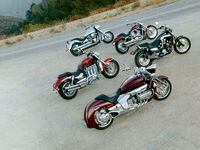
/cloudfront-us-east-1.images.arcpublishing.com/octane/H6Z2IC7WYRBXZNQS4MI3SZ5KPQ.jpg)
/cloudfront-us-east-1.images.arcpublishing.com/octane/IWO5T5PBT5E4HFQ5GK47H5YXR4.jpg)
/cloudfront-us-east-1.images.arcpublishing.com/octane/OQVCJOABCFC5NBEF2KIGRCV3XA.jpg)
/cloudfront-us-east-1.images.arcpublishing.com/octane/F3O2DGLA4ZBDJGNVV6T2IUTWK4.jpg)
/cloudfront-us-east-1.images.arcpublishing.com/octane/ZXYQE3MHLFDSPKNGWL7ER5WJ4U.jpg)
/cloudfront-us-east-1.images.arcpublishing.com/octane/RDF24VM7WVCOBPIR3V3R4KS63U.jpg)
/cloudfront-us-east-1.images.arcpublishing.com/octane/W7RSIBFISNHJLIJESSWTEBTZRQ.jpg)
/cloudfront-us-east-1.images.arcpublishing.com/octane/AERA26ENRNBW3K324YWCPEXYKM.jpg)
/cloudfront-us-east-1.images.arcpublishing.com/octane/YWX3YX7QBBHFXFDMEEEKRG4XJE.jpg)
/cloudfront-us-east-1.images.arcpublishing.com/octane/I7OKI53SZNDOBD2QPXV5VW4AR4.jpg)
/cloudfront-us-east-1.images.arcpublishing.com/octane/IH52EK3ZYZEDRD3HI3QAYOQOQY.jpg)
/cloudfront-us-east-1.images.arcpublishing.com/octane/K2FSAN7OWNAXRJBY32DMVINA44.jpg)
/cloudfront-us-east-1.images.arcpublishing.com/octane/G4XK7JL24FCUTKLZWUFVXOSOGE.jpg)
/cloudfront-us-east-1.images.arcpublishing.com/octane/JJNXVAC27ZCDDCMTHTQZTHO55Y.jpg)
